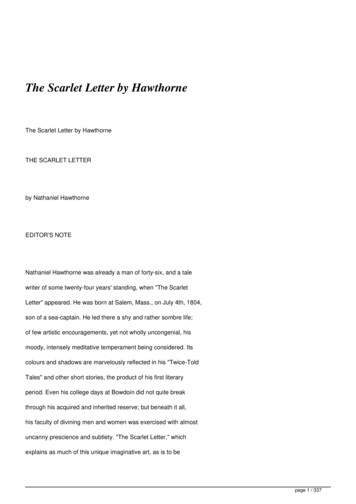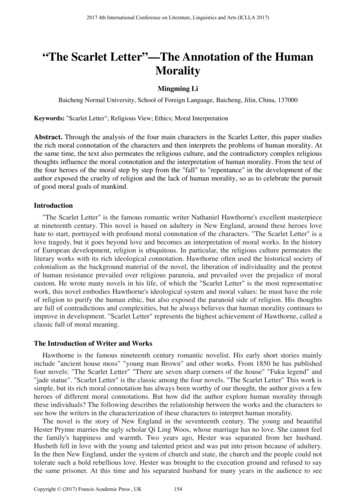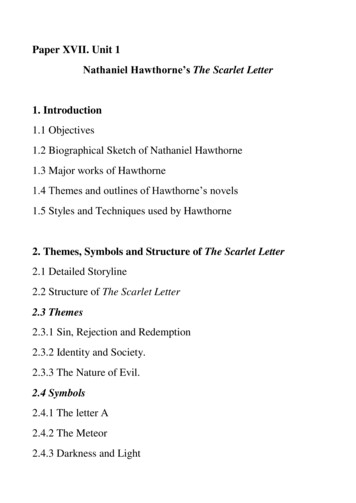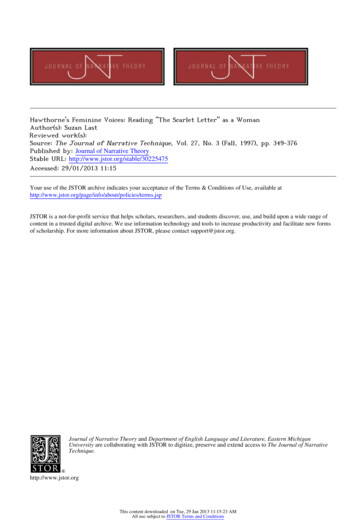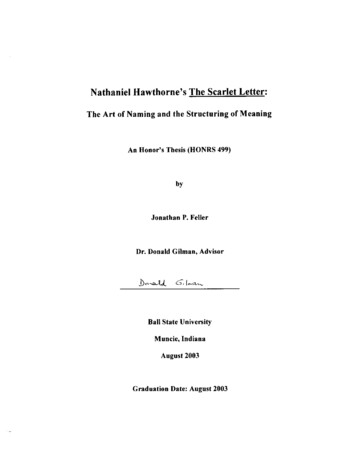
Transcription
ISSN 1798-4769Journal of Language Teaching and Research, Vol. 9, No. 3, pp. 474-479, May 2018DOI: http://dx.doi.org/10.17507/jltr.0903.04The Scarlet Letter: EmbroideringTranscendentalism and Anti-transcendentalismThread for an Early American WorldRamtin Noor-Tehrani (Noor) MahiniAcalanes High School, Lafayette, California, USAErin BarthAcalanes High School, Lafayette, California, USAAbstract—Published in 1850 by Nathaniel Hawthorne, the dark romantic story of The Scarlet Letter wasimmediately met with success, and Hawthorne was recognized as the first fictional writer to truly representAmerican perspective and experience. At the time when most novelists focused on portraying the outsideworld, Hawthorne dwelled deeply in the innermost, hidden emotional and mental psyches of his characters.Despite being acquainted to both famed transcendentalists Ralph Waldo Emerson and Henry David Thoreauand married to the transcendentalist painter Sophia Peabody, Hawthorne was often referred to as antitranscendentalist or dark romantic writer in The Scarlet Letter. Is he also influenced by the transcendentalistmovement in his famed novel? Evidence shows that he is more transcendentalist than anti-transcendentalist inThe Scarlet Letter.Index Terms—Nathaniel Hawthorne, Scarlet Letter, Hester Prynne, Roger Chillingworth, Arthur Dimmesdale,Pearl, transcendentalism, dark romanticism, anti-transcendentalismI. INTRODUCTIONRiding the wave of heightened nationalism after the second independence war against Great Britain in 1812,Americans began to write their own school textbooks, celebrate the birth of American literature using American scenesand themes, and even establish their own American intellectual, philosophical, and social movements. One of thesemovements is the American transcendentalism that began in the mid-nineteenth century (1830-1860) in Boston andConcord of New England. This transcendentalist movement was inspired by the publication of Ralph Waldo Emerson’sessays, “Nature” in 1836 and “Self-Reliance” in 1841. Stemming from the larger 19th-century European romanticism,New England transcendentalists (Goodman, 2017; Habich and Nowatzki, 2010) reject Calvinism, or the doctrine ofpredestination practiced by the Puritans, by asserting that human nature is innately good and that truth can be acquiredfrom intuition and nature, not from reason and logic. As such, authority or society-imposed formal institutions such asgovernment and religion may prevent people from using their intuition and cause them to become corrupt. In contrastwith transcendentalism, anti-transcendentalism (better known as dark romanticism) is based on the belief that evil andsin are inherent characteristics in human beings. Therefore, optimistic outlook on humanity is naïve because peoplemust struggle to obtain goodness and avoid evil, which can exist even in a physical form in society.As an American novelist during this interesting time of contrasting intellectual and literary philosophies, NathanielHawthorne weaves both transcendentalism and anti-transcendentalism thread into his immediately successful novel TheScarlet Letter to give readers a chance to evaluate different beliefs and different aspects of the early American life at theNew England settlement in the seventeenth century. His story revolves around the life of a young and married HesterPrynne who is punished by her Puritan village to perpetually wear a scarlet letter “A” on her bosom for committingadultery in the absence of her husband, Roger Chillingworth. She gives birth to Pearl, an illegitimate child from hersecret affair with the Puritan Reverend Arthur Dimmesdale. At times, Hester and those immediately related to her seemto espouse both or even wrestle between these two contradictory transcendentalist and anti-transcendentalist beliefsystems, as Hawthorne explores the psychological effects of sin and guilt while simultaneously examining the innerstruggle between good and evil through his characters.II. BACKGROUNDPublished in 1850 by Nathaniel Hawthorne, the dark romantic story of The Scarlet Letter was immediately met withsuccess. It had made quite an impact on Europe’s literary circles, portraying Hawthorne as the first fictional writer totruly represent American perspective and experience. At the time when most novelists focused on the outside world,Hawthorne dwelled deeply in the innermost, hidden emotional and mental psyches of his characters. More than one anda half century later, The Scarlet Letter is now part of the American literary canon, invoking incessant critical reviews on 2018 ACADEMY PUBLICATION
JOURNAL OF LANGUAGE TEACHING AND RESEARCH475its numerous and rich political, religious, scientific, and social themes. The wide range of modern themes on TheScarlet Letter includes: feminism (Daniels, 2005; Wang, 2010); literary symbolism (Lei, 2015); medicine/toxicology(Khan, 1984; Applebaum, 2008); morality (Taylor, 2005; Bloom, 2011); politics (Hunt, 2009; Strong, 2017); sociocultural aspects (Young, 2007; Kumar, 2016); or socio-religious topics such as Christianity (Stuart, no date; Walsh,2009), Islam (Hariyanti and Nurhayati, 2017), and Puritanism (Gao et al., 2014), etc.Despite being acquainted to both famed transcendentalists Ralph Waldo Emerson and Henry David Thoreau andmarried to the transcendentalist painter Sophia Peabody, Hawthorne was often referred to as an anti-transcendentalist ordark romantic writer in The Scarlet Letter because he shows his disagreement with the transcendentalist point of viewby describing the presence of sin (Trepanier, 2003) and evil in man, or human tendency toward evil (Manzari, 2012). IsHawthorne also influenced by the transcendentalist movement? In The Scarlet Letter, is he more anti-transcendentalistor more transcendentalist? The answers are presented in later sections of this article. As Hawthorne selects his weak,pitiful anti-transcendentalist characters as male and depicts good-natured, self-reliant transcendentalist characters asfemale in his famed novel, perhaps Hawthorne can also be considered an American feminist writer ahead of his time.III. TRANSCENDENTALIST ASPECTS OF THE SCARLET LETTERThe Scarlet Letter contains both transcendentalist and anti-transcendentalist views and ways of life organizing aroundthe central theme of sin. Hester’s sin is her adultery with Dimmesdale, which produces her child Pearl. Dimmesdale’ssin is his failure to publicly admit his act of adultery with Hester. And Chillingworth’s sin is his ruthless torture ofDimmesdale, despite the latter’s remorse and sufferings. The basic premises of transcendentalism depicted in the novelinclude beliefs in self-confidence and self-reliance, in transforming or changing for the better, in individual worth anddignity of manual labor, in innate goodness of people, in the benefits of living close to nature, and in the fact that truthis acquired through intuition, not reason nor logic.A. Self-confident, Self-reliant, and Dignity of Manual LaborIn The Scarlet Letter, it is initially determined by the local government that the typical penalty of death for adultery ismercifully reduced due to the fact that Hester’s husband may already be “at the bottom of the sea” (deceased) and shecan be effectively considered a widow (Hawthorne, 1850, p. 60). As a result, Hester is condemned to stand on thescaffold for three hours at mid-day for public humiliation and wear the scarlet letter A on her chest for the remainder ofher life. Although Hester is initially filled with grief and shame for being subject to ridicule and harsh judgment by thetownspeople, she chooses to be self-confident and self-reliant. She walks with dignity and displays her own free will,“ he placed his right upon the shoulder of a young woman, whom he thus drew forward; until, on the threshold of theprison-door, she repelled him, by an action marked with natural dignity and force of character, and stepped into theopen air, as if by her own free-will.” This image shows that when the town beadle tried to force Hester to move forwardfrom the prison door, the dignified and proud Hester rejected his force. She would not let authorities of her society pushher around and make her feel weak and vulnerable.Hester even embroiders the condemned scarlet letter A with luxurious red velvet and gold thread on her chest,“ was that SCARLET LETTER, so fantastically embroidered and illuminated upon her bosom. It had the effect of aspell, taking her out of the ordinary relations with humanity, and inclosing her in a sphere by itself” (Hawthorne, 1850,p. 52). This sentence depicts Hester’s strong will to turn her life around, despite her adversity. Instead of letting thescarlet A letter be a symbol of her shame, she selects the finest red cloth and embroiders the letter A with illuminatedgold thread to celebrate her unique life, away from the relation with her fellow Puritan society. Perhaps, instead ofwearing the typical scarlet letter A as a symbol of shame (Adultery), she proudly wears hers as a token love forDimmesdale (the initial letter of Arthur, Reverend Dimmesdale’s first name) and continues to live a life undisturbed bythe harsh judgment of others around her.To support her infant child Pearl, Hester settles on the outskirts of town, in an abandoned cottage that is next to theseashore and surrounded by the forest to the west (Hawthorne, 1850, p. 78). Alone, she utilizes her skills in needleworkto make a living and raise Pearl. She does not leave town, perhaps with a dream to reunite with her lover againsomeday.B. Transformation and Innate Human GoodnessDuring the early years of her seclusion from society, Hester experiences some transforming or changing in herself,“to the credit of human nature, that, except where its selfishness is brought into play, it loves more readily than it hates.Hatred, by a gradual and quiet process, will even be transformed to love, unless the change be impeded by a continuallynew irritation of the original feeling of hostility” (Hawthorne, 1850, p. 156). This transformation in Hester, from angeror resentment to love, is a clear display of transcendentalism. She can experience the beauty of love due to good humannature, reflecting transcendentalist ideology. Because of her transformation and her innately good character, Hesternever stops helping those who are destitute or sick around her, “Except for that small expenditure in the decoration ofher infant, Hester bestowed all her superfluous means in charity, on wretches less miserable than herself, and who notunfrequently insulted the hand that feed them she employed in making coarse garments for the poor ” (Hawthorne,1850, p. 80). It should be noted that her kind-hearted actions are not required or imposed by the law, as she is shunned 2018 ACADEMY PUBLICATION
476JOURNAL OF LANGUAGE TEACHING AND RESEARCHby society and even looked down by people whom she helps. Her “human tenderness,” a prominent transcendentalistcharacteristic, causes the town people to begin to appreciate her charity work; they see the change in the meaning of thefiery letter A on her chest, from “Adultery” to “Able” (Hawthorne, 1850, p. 158). They proudly talk about her tonewcomers to town; and the town leaders also start to propose the removing of her sign of punishment, the scarlet letterA, from her chest after only seven years (Hawthorne, 1850, p. 165). Hester’s decision to openly acknowledge her sinallows her to keep it from destroying her from the inside, to move on with life, to seek forgiveness, and to flourish as an“able” and caring individual in society – thereby increasing the worth of herself and her societal standing.C. Living Close to NatureLiving on the outskirts of town with Pearl, surrounded by nature - the sea and the woods, Hester also starts to learnabout herself, “She had wandered, without rule or guidance, in a moral wilderness Her intellect and heart had theirhome, as it were, in desert places For years past she had looked from this estranged point of view at humaninstitutions The tendency of her fate and fortune had been to set her free” (Hawthorne, 1850, p. 196). Because of heracquired freedom of thought or of speculation, she can comfortably advise her lover, Reverend Dimmesdale, of thevarious actions he can take to reduce his guilt and sufferings after she discloses to him that Chillingworth is theassumed entity of her long-lost husband (Hawthorne, 1850, p. 193).It is in the forest, or nature, where Hester and Dimmesdale reconnect their feelings for each other - and natureresponds with a burst of sunshine to celebrate “the bliss of the two spirits! Love ” (Hawthorne, 1850, p. 199). Here inthe deep forest, Hester and Dimmesdale can put down their guard, reclaim their deep love toward each other, and agreeto escape together to England to begin their life anew, “Do I feel joy again O Hester, thou art my better angel!.Thisis already a better life! Why did we not find it sooner?” (Hawthorne, 1850, p. 198). This special moment shows thatsociety-imposed formal institutions such as government and religion collapse in the heart of this couple deeply inlove. Seven long years of immense guilt and harsh punishment imposed by society cannot change them and cannotdeter them from committing their “sin” again, out of love.The woods, the seaside, and the nature surrounding Hester and Pearl are also the places where the innocent Pearl isfree to express herself, “The truth seems to be, however, that the mother-forest, and these wild things, which itnourished, all recognized a kindred wildness in the human child. And she was gentler here than in the grassy-margainedstreets of the settlement, or in her mother’s cottage,” to develop her free-spirit character, and to become independentlike her mother, “In the little chaos of Pearl’s characters, there might be seen emerging-and could have been, from thevery first-the steadfast principles of an unflinching courage-an uncontrollable will-a sturdy price, which might bedisciplined into self-respect which she inherited from her mother must be great indeed ” (Hawthorne, 1850, p. 176).Just like Hester, Pearl is a wonder because she is independent and is not corrupted by institutional rules and laws ofsociety.D. Acquiring Truth through IntuitionIn addition, Pearl becomes an observant child full of intuition because she somehow feels and guesses thatDimmesdale is her father without him admitting it or without her mother telling it to her. As a three-month old infant,Pearl instinctively responds to Dimmesdale’s voice at the first scaffold scene (Hawthorne, 1850, p. 65). As a three-yearold child, she tenderly caresses Dimmesdale’s hand when the minister argues on her mother’s behalf to keep her(Hawthorne, 1850, p. 112). As a young girl, she asks Dimmesdale to hold her hand and her mother’s hand on thescaffold publicly at “noontide” (Hawthorne, 1850, p. 149). At seven years old, she knows that the reason her motherwears a scarlet A on her chest is the same reason as the Reverend Dimmesdale puts his hand over his heart (Hawthorne,1850, p. 175). She also hopes that Dimmesdale can go back from the meeting in the forest to town with her and hermother “hand in hand, we three together, into the town” (Hawthorne, 1850, p. 208).IV. ANTI-TRANSCENDENTALIST ASPECTS OF THE SCARLET LETTERAs discussed above, in addition to transcendentalist aspects shown primarily in Hester and Pearl, antitranscendentalist elements are also presented in Hawthorne’s famed novel. These elements include moral corruption,guilt, hatred, revenge, etc. that are expressed prominently in the characters of Dimmesdale and Chillingworth. Thesetwo characters represent aspects of anti-transcendentalism because Dimmesdale is a man of dignity and a religiousPuritan minister, and Chillingworth is a rational man of high academic learning. In a way, Puritans are like antitranscendentalists because they believe that humans are born sinners, predestined in the eyes of God.A. Human Sin and Its Psychological EffectsDimmesdale’s decision to keep his sin a secret burdens him from the very beginning of the novel, at the first scaffoldscene. He is found to have “an air about him, an apprehensive, a startled, a half-frightened look – as of a being who felthimself quite astray and at a loss in the pathway of human existence ” (Hawthorne, 1850, p. 64). Dimmesdale’sstraying from the path of human existence exemplifies the fear of his own sin, which makes up his dark moralcorruption. 2018 ACADEMY PUBLICATION
JOURNAL OF LANGUAGE TEACHING AND RESEARCH477We know that Dimmesdale does not have the courage to admit his sin because he first refuses the older clergymanJohn Wilson’s request to question Hester about the name of her fellow sinner. Later, at the governor’s request thatDimmesdale must question Hester, he indirectly conveys to Hester that he does not have the courage to admit his sin,“Take heed how thou deniest to him-who, penchance, hath not the courage to grasp it for himself ” (Hawthorne, 1850,p. 65). In contrast to Hester, who embraces her sin to transform and grow the strength in her character, ReverendDimmesdale does not have the bravery to face the consequences of his sin, which can be the death penalty under thePuritan rule.Because Dimmesdale attempts to maintain his composure as a dignified religious leader, his guilt manifests as hishealth continuously deteriorates, and his self-respect is diminished throughout the novel. As time goes on, he isdescribed as “emaciated; his voice, though still rich and sweet, had a certain melancholy prophecy of decay in it; he wasoften observed. to put his hand over his heat, with first a flush and then a paleness, indicating pain” (Hawthorne, 1850,p. 117). When Hester first sees Dimmesdale walking in the forest, “He looked haggard and feeble, and betrayed anerveless despondency in his air” (Hawthorne, 1850, p. 184). He also personally admits to Hester, “ whatever of goodcapacity there originally was in me, all of God’s gifts that were the choicest have become the ministers of spiritualtorment. Hester, I am most miserable!” (Hawthorne, 1850, p. 187).Except for the description of Dimmesdale’s guilt and physical/emotional pain, readers learn nothing about the growthof Dimmesdale as a character, unlike Hester. He does not develop any valuable virtue out of his seven remorseful years,and he even admits to Hester that he has plenty of penance but does not achieve penitence (Hawthorne, 1850, p. 188).Despite Hester’s complete devotion, Dimmesdale lacks courage, “Think for me, Hester. Thou art strong. Resolve forme” (Hawthorne, 1850, p. 192), honesty, and morality. Hiding behind the protection of his revered priesthoodprofession and social position as a result of Hester’s courage, he even admits that children naturally do not like him(Hawthorne, 1850, p. 203). Young and innocent children have an instinct to recognize naturally good-hearted people.On the other hand, Dimmesdale knows that he has the magic power under the veil of pure and religious devotion toattract young women and virgins in his congregation, perhaps just like with Hester years ago when she was vulnerableat the time of her loneliness (Hawthorne, 1850, p. 215). Perhaps, Dimmesdale truly loves and admires Hester for herstrength, because he refuses to take any virgin as his wife when suggested by the townspeople (Hawthorne, 1850, p.122).When Dimmesdale agrees to flee town with Hester (thereby committing another sin), he finds himself so liberated ofthe first burden that he has carried around for seven years that he wants to act out of his normally respectful character,by wanting to use profanity language on children or to flirt with virgin congregationalists of his church. This makes usquestion if his guilt or remorse for the past seven years is totally sincere. But the weight of his sin is not so easilypurged, and he suddenly becomes very weak. After the Election sermon, he reveals his sin to the town and dies.B. Revenge as Dark Human Emotion and ConvictionAnother character with dominant anti-transcendentalist qualities in the novel is Chillingworth, the assumed entity ofHester’s long-lost husband. Chillingworth is a highly learned man, and his sin is of different nature from Dimmesdaleand Hester. His sin resides in his persistent vindictiveness toward Dimmesdale, which turns him into a devil because heabsolutely refuses to forgive his wife’s lover.On the first day coming back to civilization after being kept by the native “Indians” for two years and upon learningof his wife’s betrayal and shame, Chillingworth decides to hide his true entity from the Puritan town because he doesnot want to be known as the husband of a shameful woman (Hawthorne, 1850, p. 74). He forgives his wife and does notseek vengeance against her because he recognizes that there is a large difference in age between them and because ofhis deformity (Hawthorne, 1850, p. 71-72). However, he thinks that his wife’s secret lover wrongs both of them,perhaps because Hester’s lover’s unconfessed sin denies her infant a father. Chillingworth then takes on a new mission“to look into the mystery” and find the hiding transgressor as he declares, “It irks me, nevertheless, that the partner ofher iniquity should not, at least, stand on the scaffold by her side. But he will be known!” and “I shall seek this man as Ihave sought truth in books, as I have sought gold in alchemy. There is a sympathy that will make me conscious of him.I shall see him tremble.Sooner or later he must needs be mine!” (Hawthorne, 1850, p. 60-61 and 73).With his great determination to revenge the hiding transgressor, Hester can feel the darkness in her husband’s heartand wonders if her husband is actually like a devil - the Black Man. The anti-transcendentalist characteristic inChillingworth manifests fully during the seven years after that fateful scaffold day, as Chillingworth relentlesslypursues his revenge, “He had begun an investigation, as he imagined, with the severe and equal integrity of a judge,desirous only of truth.He now dug into the poor clergyman’s heart like a miner searching for gold; or rather, like asexton delving into a grave” (Hawthorne, 1850, p. 125). Even after befriending Dimmesdale, learning about theminister’s secret sin, and seeing him collapse under the tremendous guilt, Chillingworth misses no opportunity tomentally torment the poor minister and lengthen his misery, instead of disclosing the minister’s sin (Hawthorne, 1850, p.167).A good-hearted man would have pardoned a guilt-ridden and repentant person like Dimmesdale, but Chillingworthrefuses to do so. That causes the suffering minister to tell Hester, when he finds out about the true entity ofChillingworth: “We are not, Hester, the worst sinners in the world. There is one worse than even the polluted priest!That old man’s revenge has been blacker than my sin. He has violated, in cold blood, the sanctity of a human heart. 2018 ACADEMY PUBLICATION
478JOURNAL OF LANGUAGE TEACHING AND RESEARCHThou and I, Hester, never did so!” (Hawthorne, 1850, p. 191). Dimmesdale is right in noting that relentless revenge is asin that is worse than any other sin committed by human beings. It causes the pain and sufferings in people toperpetuate in eternity with no ending. Against humanity, revenge can kill the human heart, restricting the ability to loveand to forgive.C. Devil in Physical FormDuring this time, another anti-transcendental characteristic is seen in Chillingworth - that is he literally becomes adevil in physical form, “At first his expression had been calm, meditative, scholar-like. Now there was something uglyand evil in his face” (Hawthorne, 1850, p. 124). Eventually Chillingworth’s evil becomes so invasive that the Puritanvillage and little Pearl could see the devil of the Black Man in him. Ironically, even Chillingworth notices that hehimself has changed from a kind, trustworthy man with “constant if not warm affections” to a devil, as he admits it toHester: “A mortal man, once with a human heart, has become a fiend for his especial torment!” (Hawthorne, 1850, p.168-169). Although Chillingworth recognizes his own transformation, he refuses to change for the better and forgiveDimmesdale. As the minister Dimmesdale dies of his weakness and moral corruption, the devil Chillingworth dieswithin a year of Dimmesdale because he lacks the subject of his vile revenge.V. CONCLUSIONSAs addressed above, there are both transcendentalist and anti-transcendentalist aspects presented in this novel.Although the elements of “sin” and “evil” are pervasive in the story, this book ends on an optimistic note about humannature - highlighting the basis of transcendentalism. It is interesting to find out in the conclusion of this story thatalthough Chillingworth harbors immense hatred and relentlessly pursues torturous revenge toward ReverendDimmesdale, he has enough empathy and tender feelings for the little innocent Pearl to leave all his great fortune inNew England and Great Britain to help the child of his eternal enemy. This generous action from the old and deformedhusband that Hester hates and betrays is astounding, considering that Hester’s lover Dimmesdale does not even helpHester raise Pearl and leaves Pearl with nothing after this death.It is also noteworthy to see that the main characters who espouse the anti-transcendentalist point of view all die off inthe novel after seven or eight years: Dimmesdale of his own tormenting guilt and Chillingworth of his incessant hatredtoward his perceived enemy. Meanwhile, the transcendentalist characters like Hester and Pearl continue to flourish andprosper in their own way. Across the Atlantic Ocean, well-to-do Pearl is described as having a good and possiblyaristocratic family life to be able to send her mother valuable gifts with armorial seals to comfort her. And when Hestercomes back to the Puritan village that initially shunned and alienated her, she continues to comfort and counsel thesuffering people around her, until the day she dies and is buried alongside with her lover. While Chillingworth andDimmesdale display human possibilities of committing evil acts and self-destruction, Hester and Pearl represent thehuman capability for healing, surviving, and thriving. Perhaps Hawthorne is suggesting to future generations thatalthough human nature is both good or bad, goodness will always 11][12][13][14][15][16][17]Applebaum, L. (2008). The Scarlet Letter: Deadly nightshake, dogwood, and henbane. The Herbarist 74, 30-33.Bloom, H. (2011). Bloom’s Guides: The Scarlet Letter – New Edition. New York: Infobase Publishing.Gao, J. et al. (2014). The influence of Puritanism on the sin and punishment in The Scarlet Letter. Research on Humanities andSocial Sciences 4(27), 175-179.Goodman, R. (2017). Transcendentalism. The Stanford Encyclopedia of Philosophy (Summer 2017 Edition), Edward N. Zalta(ed.) s/transcendentalism (Accessed 11/30/2017).Habich, R. and R. Nowatzki (2010). Research Guide to American literature: Romanticism and Transcendentalism 1820-1865.New York: Facts on File, Inc.Hariyanti, T. and D. Nurhayati. (2017). Pearl in Hawthorne’s the Scarlet Letter: a socio-religious perspective. Arab WorldEnglish Journal 1(1), 65-78.Hawthorne, N. (1850). The Scarlet Letter. Illinois, USA: Perma-Bound International. Published in 1988.Hunt, C. (2009). The persistence of theocracy: Hawthorne’s The Scarlet Letter. Perspectives on Political Science 38(1), 25-32.Khan, J. (1984). Atropine poisoning in Hawthorne’s The Scarlet Letter. The New England Journal of Medicine 311 (6), 414416.Kumar, R. (2016). Socio-cultural patterns of privacy and interconnections in Hawthorne’s The Scarlet Letter. InternationalJournal of Multidisciplinary Approach and Studies 3(5), 101-112.Lei, N. (2015). A brief study on the symbolic meaning of the main characters’ names in The Scarlet Letter. Theory andPractice in Language Studies 5(10), 2164-2168.Manzari, A. (2012). Contextual American transcendentalism. Theory and Practice in Language Studies 2(9), 1792-1801.Strong, T. (2017). Hawthorne, the politics of sin, and Puritanism. Telos. Spring 178, m.org/ScholarsForum/MMD1824.html (accessed 12/30/2017).Taylor, C. (2005). Moralism and morally accountable beings. Journal of Applied Philosophy 22(2), 153-160.Trepanier, L. (2003). The need for renewal: Nathaniel Hawthorne’s conservatism. Modern Age 45(4), 315-323.Wang, Y. (2010). A representative of the new female image – Analyzing Hester Prynne’s feminist consciousness in The Scarlet 2018 ACADEMY PUBLICATION
JOURNAL OF LANGUAGE TEACHING AND RESEARCH479Letter. Journal of Language Teaching and Research 1(6), 893-897.[18] Walsh, C.M. (2009). Nathaniel Hawthorne with His Biblical Context. PhD Dissertation. University of issertations/1115/ (Accessed 12/30/2017).[19] Young, R.V. (2007). Individual and Community in The Scarlet Letter. The Intercollegiate Review, 32-40.Noor (meaning Light) Mahini (full name Ramtin Noor-Tehrani Mahini) was born in October 2001 inBerkeley, CA and is currently a junior at Acalanes High School in Lafayette, CA, USA. Noor has been a highachieving student since middle school, excelling in computers, math, and science. He applies his deep criticalthinking in most things he does, especially in writing English essays and in conducting a small climate changeresearch project awarded by the Acalanes Parents Club at school. Raised by first-generation immigrant parents(Ramtin T. and Xuannga, who received PhD/engineering and MPH/toxicology, respectively, from Universityof California, Berkeley), Noor’s life purpose is to develop a morally respectable character and to become aresponsi
transcendentalist or dark romantic writer in The Scarlet Letter. Is he also influenced by the transcendentalist movement in his famed novel? Evidence shows that he is more transcendentalist than anti-transcendentalist in The Scarlet Letter. Index Terms—Nathaniel Hawthorne, Scarlet Letter, Hester Prynne, Roger Chillingworth, Arthur Dimmesdale,


